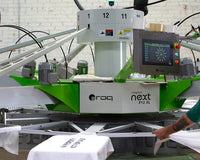News

Get Perfect Exposure Results for Every Screen with V-LUX Exposure Unit
The V-LUX UV-LED Exposure System delivers significant upgrades to screen printing. Traditional systems can wear down and lead to inconsistent results over time, but the V-LUX’s UV-LED technology keeps your screens exposed quickly and accurately. With exposure times as short as 10 seconds, it ensures reliability and smooth production for your shop.

How to Burn Multiple Designs on One Single Screen
By aligning multiple films on one screen, you can print various designs in a single go, saving both time and resources. Whether you're printing fro...

Deep Dive W/ Colin Episode 2 | Black Ink Density For Film Output
Welcome to the second episode of "Deep Dive with Colin." In this episode, Colin explores film positives and how important film density is in screen...

A Guide to Industry Standard for Screen Print Placements and Dimensions
There’s a lot to consider when talking about print placement on a garment. How tall should it be? Where should it be placed? Don’t worry about having all the answers. Here’s a guide to lining up and sizing popular design placements on garments.

Compression vs. Vacuum Exposure Units
Thinking about getting a new exposure unit, or are you ready to upgrade your current unit? Many different kinds of exposure units exist, but let's look into one angle — compression and vacuum exposure units. We'll decipher the differences between the two, how to determine which one is best for you, and other darkroom details.

Dehaze, Degrease, De-Ghost with Sgreen® Stuff
Sgreen® Stuff, a dynamic dual-action dehazer and degreaser, is your secret weapon against ink haze, oils, and contaminants. It's your key to ensuring that your emulsion adheres perfectly to the screen. Let's dive into how to make the most of this powerful screen printing chemistry.

What a Screen Drying Cabinet Does for Your Darkroom
To create a stellar print, you need a solid screen. Using high-quality emulsion and dialing in exposure times help, but it's a fraction of what's needed. Your darkroom matters. One major update to make in your darkroom is to invest in a drying cabinet. It’s the perfect screen drying environment, equipped with everything you need to dry screens better. Let’s talk about how a drying cabinet can increase your darkroom’s potential and make your screen prep process that much easier.

How Moving Shops Helped Abi-Saad Print & Design Work Toward Goals and Create Community
Moving to a new shop space is exciting but also intimidating. The process can be riddled with challenges or go smoothly. Anthony Abi-Saad found both when he moved his shop, Abi-Saad Print & Design, to a new location in Taunton, Massachusetts. It wasn’t the first time he’d moved, but it was a big new challenge. One main challenge: creating a darkroom from scratch. With a bit of creativity and some expert help, he was able to make it all happen.

Why is LED Exposure Better and How Does it Work?
LED exposure units are the new standard for any screen printer’s darkroom. But why? Many factors make LED light optimal: light output, speed, consistency, and more. Here are three benefits of using LED exposure bulbs in any darkroom.

Screen Coating Basics Live Stream
Every screen print starts in the darkroom, and every screen starts with a good coat of emulsion. Follow along as darkroom expert Colin Huggins walks through the basics of mixing dual cure emulsion and coating screens.

Streamline Your Printing Prep Process with These 6 Tips
A screen printing job takes a lot of man hours. The whole process, from art prep to screen reclaim, takes time and effort to constantly hone in processes and learn from mistakes. The pre-press process — everything you do before setting up the press for a print run — is a big part of the screen printing process. Want to improve productivity and streamline this process? Here are six ways to dial in the pre-press process.

Use Scrap Wood to Create a DIY Emulsion Coating Stand in 5 Steps
Coating a screen is important to create the perfect base layer for a great print. Accomplishing this task can be done in a couple of different ways. You can coat screens by supporting the screen on the floor or creating a coating stand. Want to create a DIY coating stand? Here’s how to get it done.





